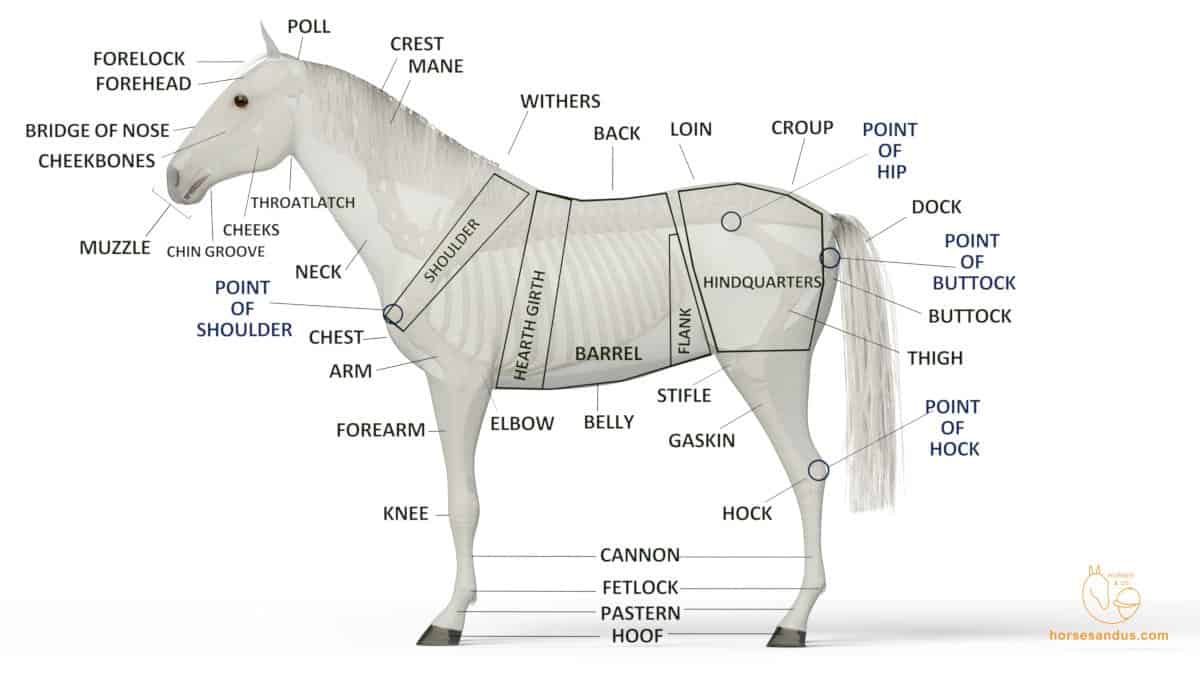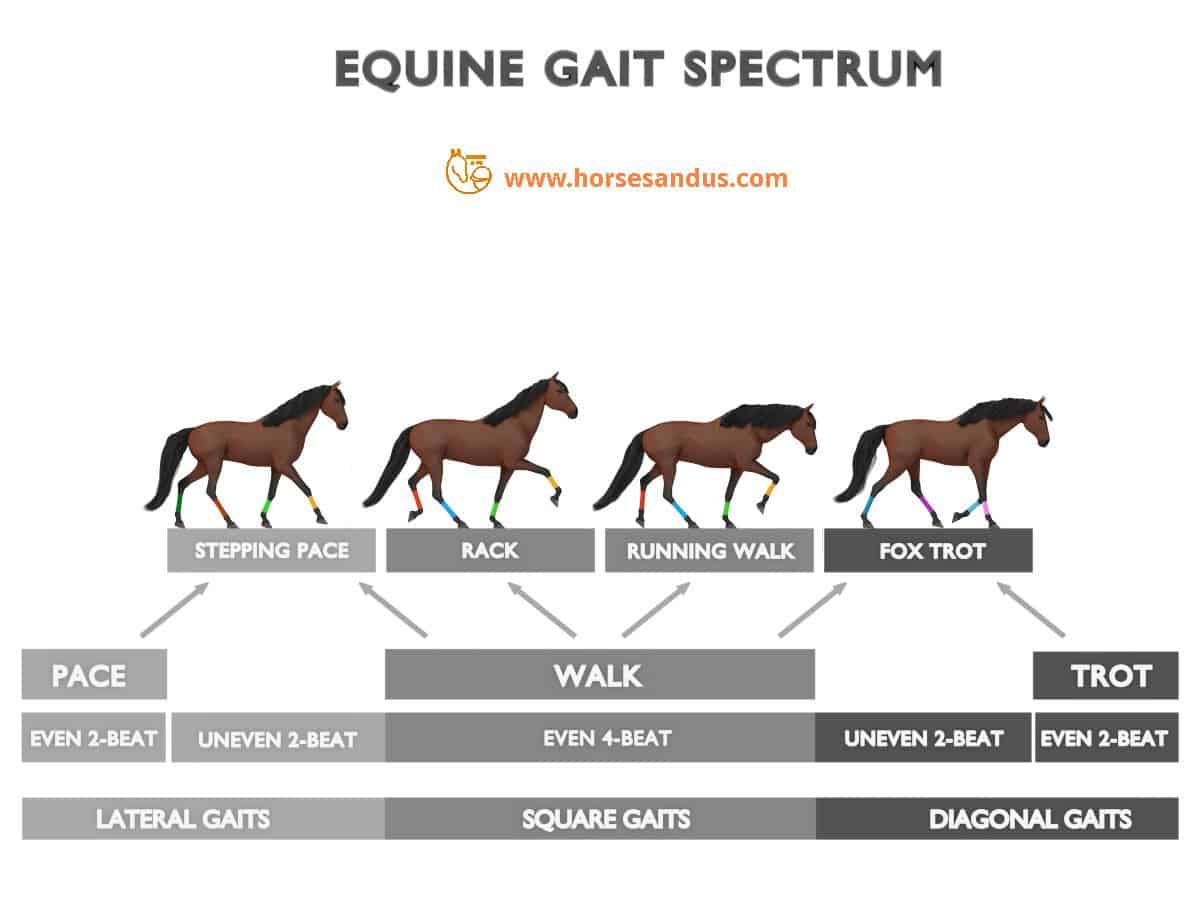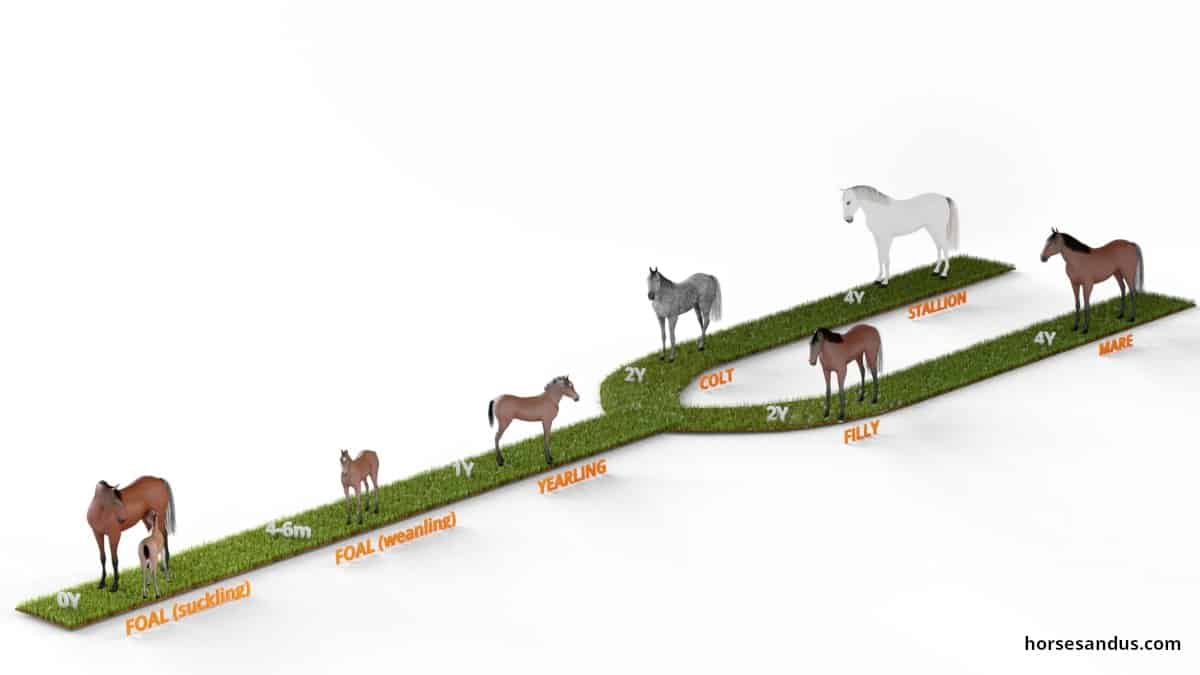There are several names given to baby horses, and this can lead to some confusion. But it’s actually easy to know the right terminology because it is based on age and gender.
A baby horse until one year of age is called a foal. Specifically, a “suckling” foal when it’s still nursing and a “weanling” foal after it’s separated from its mother (weaned). After one year of age, it’s no longer considered a baby horse and will have different names depending on its age and gender.
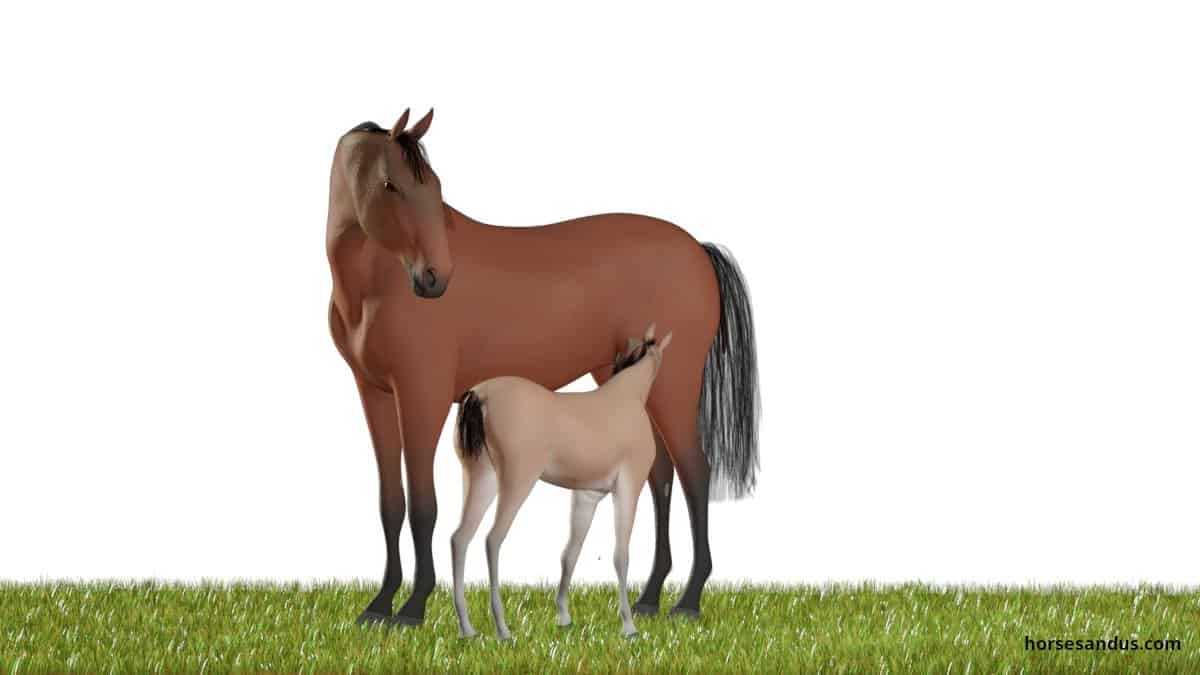
Keep reading to learn the correct terminology for young horses and interesting facts about foals.
The Terminology Used For Young Horses
This article will cover the different terminology used for young horses until the age of four. After the age of four, the horse is already considered an adult.
For terminology related to the complete lifecycle of the horse, you may want to read “the 5 stages of a horse’s life cycle.”
As the baby horse continues to grow, the names used to describe them will change. The following image shows the different names used to describe young horses until four years of age.
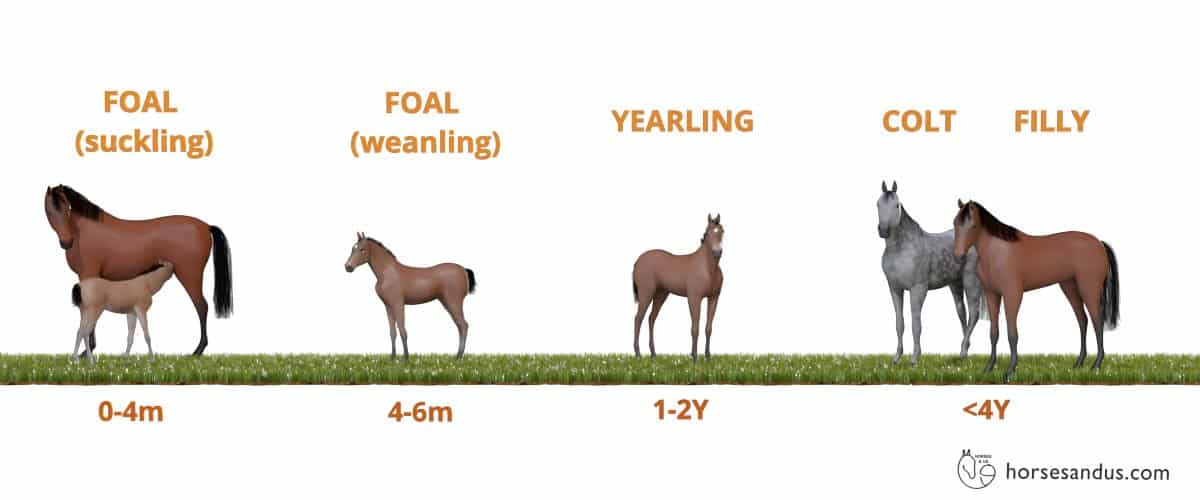
What Is A Suckling (Foal)?
A suckling foal is a baby horse that is still nursing on its mother. The foal is considered a suckling until it is separated from its mother (weaned).
What Is A Weanling (Foal)?
A weanling foal is a baby horse that has been weaned, i.e., it is no longer getting milk from its mother.
A foal is usually weaned between four and six months old.
What Is A Yearling?
A yearling is a male or female horse over the age of one year until two years. It is no longer considered a baby horse and therefore not called a foal anymore.
Yearlings are nearly always fully weaned and independent of their mothers.
What is a Colt?
A colt is a young male horse under the age of four.
What is a Filly?
A filly is a female horse under the age of four. In some places, a female horse is considered a filly until the age of five.
A Pony is not a Baby horse
Some people may think that a pony is a baby horse because of its small size. But this is not correct. A Pony is a type of horse with certain characteristics, and it is called a pony during all its lifetime, not only when it is a baby.
You may like to check our article explaining the difference between a pony and a baby horse.
The Foal’s First Year
After 11 months of waiting, wondering, and anticipating, the foal has finally arrived. As soon as the foal is born, profound changes take place in his body.
Read on to be informed about the normal events that occur right after the birth of the baby horse. With this knowledge, you can be prepared to take action in case you notice any deviation.
However, you may miss the first events because foals are often born at night, which happens very quickly. The mare will look for privacy and a safe place to give birth and can actually delay the process for some hours until it finds suitable conditions. This is an evolutionary adaptation to protect the mare and foal from predators when they are most vulnerable.
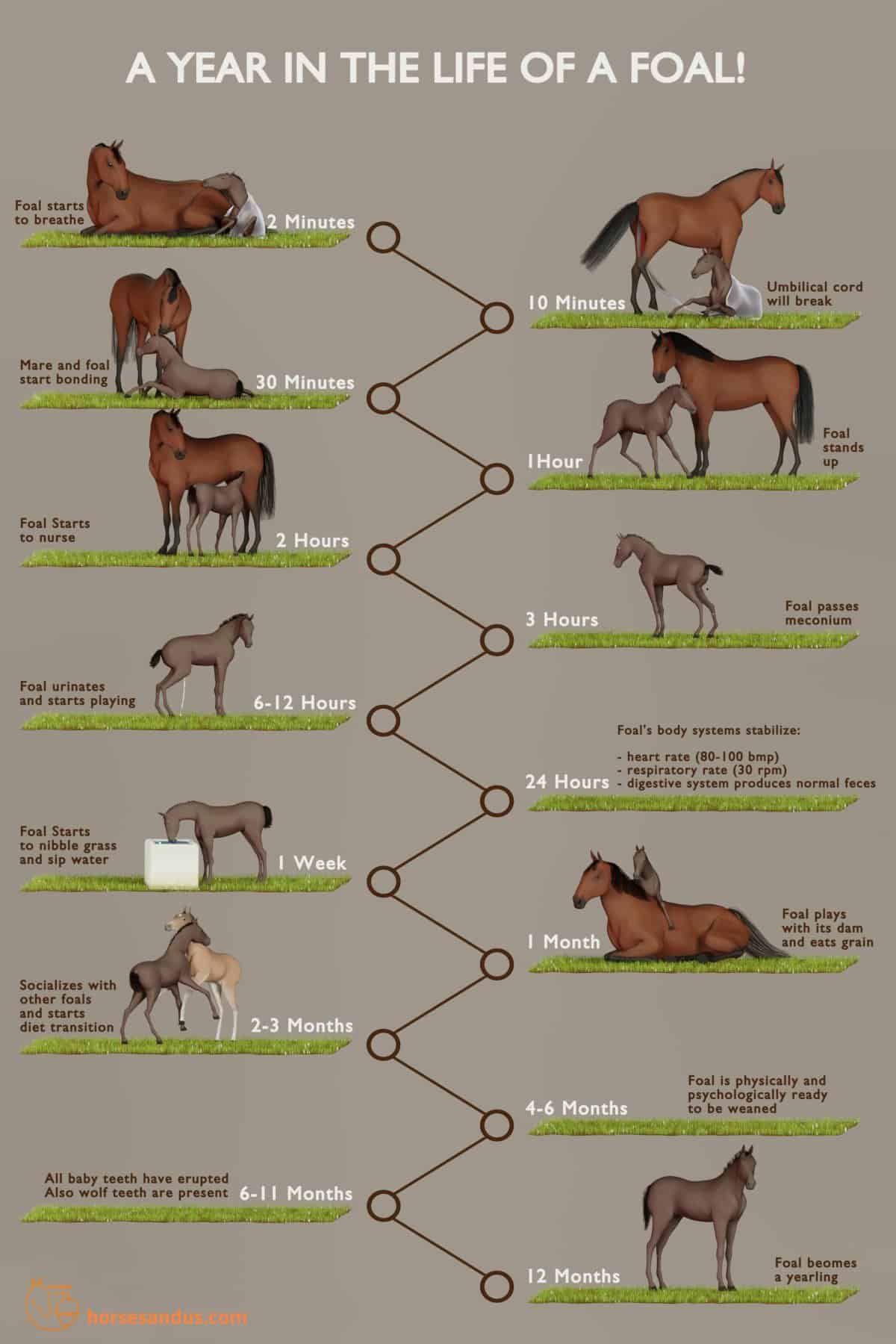
2 Minutes
Foal starts to breathe
Within 30 seconds, the foal will start to breathe. This is the most important single event and needs to be completed within 2 minutes; otherwise, serious problems can occur.
The first breaths will be irregular as the airway is cleared for the first time. Also, some liquid will be released through his nose as most of the fluid inside the fetus’s lungs is squeezed out.
The foal will shake his head, look around, and roll onto its chest.
10 Minutes
The Umbilical cord will break
The umbilical cord will naturally break (a few inches from the foal’s body) either after the mare stands up or when the foal moves around.
30 Minutes
Mare and foal start bonding
After the mare has rested for some minutes, she will stand up and start to nuzzle and lick the foal to stimulate and dry him. This interaction is important to establish the bond between the mare and the foal. During this process, they will learn the scents and vocal cues of one another to recognize each other. The is the ideal time for humans to start imprinting training.
1 Hour
Foal stands up
The foal will take an interest in its surroundings and make the first wobbly attempts to stand up. After trying several times, most foals will stand during the first hour of birth. When standing, the foal will be unsteady and always shifting its head, neck, and feet to keep itself balanced.
If the foal does not manage to stand up and stops trying, the mare will nuzzle and even bite him to encourage him to stand up. Being a prey animal, the foal must stand up and run as soon as possible to survive.
Some foals have weak legs with their fetlocks touching the ground, but they will usually straighten up after a few days. But if this condition persists, you should call your vet.
2 Hours
Foal starts to nurse
After standing up, the foal will start a wobbly walk towards the mare and search for the udder to nurse. It will often look in dark places such as stall walls and corners on the mare’s wrong side until it finally reaches the udder. Sometimes the mare will circle around and nuzzle the foal to help it find the udder.
The foal’s first attempts to suckle will be quite sloppy, but it will become more competent after a few hours. He will nurse every 10 to 20 minutes.
When the foal is born, its immune system isn’t completely developed, so the foal must get the antibodies from the mare’s colostrum. Colostrum is the first milk produced by the mare after the foal is born. It is thick, yellowish, and full of antibodies.
For healthy development, the foal must get colostrum as soon as possible because its digestive system can only absorb the antibodies within the first 12 hours of life.
3 Hours
Foal passes meconium and mare passes the placenta
The foal has started to pass its first feces called meconium. Meconium is composed of intestinal secretions and amniotic fluid ingested while in utero. It is typically dark brown, black, or green colored and can be pasty or firm like pellets. Due to its consistency, the foal will usually strain to push the meconium out. If meconium is not passed within the first 24 hours of birth, it is considered retained and can lead to colic.
Once the foal is born, the placenta is no longer needed and uterine contractions will help expel it. Most mares pass the placenta shortly after the foal is born. If this doesn’t happen within 3 hours, then it’s considered a retained placenta, and the vet should be called.
The 1-2-3 Rule
There are 3 vital steps that the foal and mare must take to assure a safe transition from pregnancy to a healthy new foal and mare.
- 1 hour – The foal stands
- 2 hours – The foal nurses
- 3 hours – The mare passes the placenta
These steps can happen earlier, but this is the longest you should wait. If any step is missing, you should call your vet.
6-12 Hours
Foal urinates and starts playing and running
The foal will urinate for the first time. Female foals will urinate within 6 hours, and male foals within 12 hours. (source)
During the first couple of days, the foal will frequently urinate (every time it stands up) and produce around 7.5 liters of urine per day.
Its energy levels will increase, and it will get up frequently to nurse and start playing and running in short spurts. It will have a short springy gallop, which can be observed when it tries to keep up with the dam
Its legs are already 80 to 90 percent of their adult legs.
24 Hours
The foal’s body systems have stabilized
Its respiratory rate has stabilized to 30 breaths per minute and heart rate to 80 to 100 beats per minute.
| Foal´s Age | Heart Rate (bpm) | Respiratory Rate (rpm) |
|---|---|---|
| 1 minute | 60-80 | Irregular (gasping) 60-80 |
| <2 hours | 120-150 | 40-60 |
| 12 hours | 80-120 | 30-40 |
| 24 hours | 80-100 | 30 |
The mare’s colostrum will be replaced by milk. The foal has entered a routine of nursing every 10 to 20 minutes.
The foal’s digestive system stabilizes and will start to produce the normal yellowish feces that result from consuming milk.
It stands up easily and is playful, and its greatest risks for survival have passed.
1 Week
Foal starts to nibble at grass and drink sips of water
During the first week, the foal will imitate its mother and start nibbling at grass and also drinking sips of water.
At this age, most of the foal’s baby teeth have already erupted. Four incisors and all twelve premolars.
1 Month
Foal plays alone or with its mother, eats grain, and increases water needs
The foal nurses less frequently, around once per hour, and eats small amounts of grain. It will also start drinking more water, about 4 liters (1gallon) per day. Although the foal is still nursing, it also needs to drink water.
During the first month, the foal still stays close to the dam (within 16 feet / 5 meters) for most of the time and does not interact with the rest of the herd.
It plays alone, running and bucking, and also likes to play with the mother’s tail, mane, and ears.
2 to 3 Months
Socializes with other foals and starts a diet transition.
The foal shows signs of independence from the dam by leaving its side more frequently and starts to socialize and play with other foals.
It also starts mutual grooming (allogrooming) with other foals. This consists of using their incisors to scratch and gently bite each other’s skin in the withers, neck, and crest. These areas are usually difficult for an individual horse to groom, so there’s a benefit in allogrooming, and it establishes social bonding.
Approximately 2 months after birth the quantity and quality of the mare´s milk will start to decrease and will no longer be enough for the foal´s nutritional needs.
At this point, the foal should start to be offered other feed such as concentrate and forage to cover its nutritional requirements. This will also prepare the foal for the diet it will have after weaning.
4 to 6 Months
The foal Is physically and psychologically ready to be weaned
Within this timeframe, the foal’s digestive system is sufficiently developed to fully process grain and forage for its nutritional needs. It has steadily decreased the duration and frequency of nursing and increased that of grazing.
The foal is now quite independent and does not seek as much social interaction with its dam, which signals that it is ready for weaning.
Weaning is a very stressful event for the foal because it breaks the comforting bond it has with the dam. It should, therefore, be done with care.
Its age isn’t as important as its physical and psychological development. So before weaning a foal, he should be receiving most of his nutritional needs from grain and forage. Also, he should show clear signs of independence from its dam and regularly socialize with other foals.
6 to 11 Months
All baby teeth have erupted
The foal´s baby teeth will all be erupted by 9 months of age. Additionally, the permanent wolf teeth will also be present when the foal is one year old.
12 Months
The foal becomes a yearling
By the time the horse reaches one year of age, it is no longer considered a baby horse and is not called a foal anymore. It is now referred to as a yearling.
How To Predict A Foal’s Adult Height
Most horse owners will like to know how tall the foal will be when it reaches adulthood.
The horse’s legs are almost full length when it is still a foal. The growth of a horse happens mostly during the first year (after this period, the growth rate slows down considerably). So the horse´s horse’s full height can be roughly determined by measuring the foal´s legs.
Although not completely accurate, many people use the following methods to get an idea of the foal’s mature height.
The String Test
- Hold one end of the string at the foal’s elbow
- The other end of the string will be placed at different places depending on the foal´s age:
- Less than 4 months – placed on the ground
- 5 to 6 months – placed halfway from the fetlock to the ground
- 12 months – placed a fourth of the way from the fetlock to the ground
- Turn the lower end up and hold it against the foal´s withers perpendicular to the ground
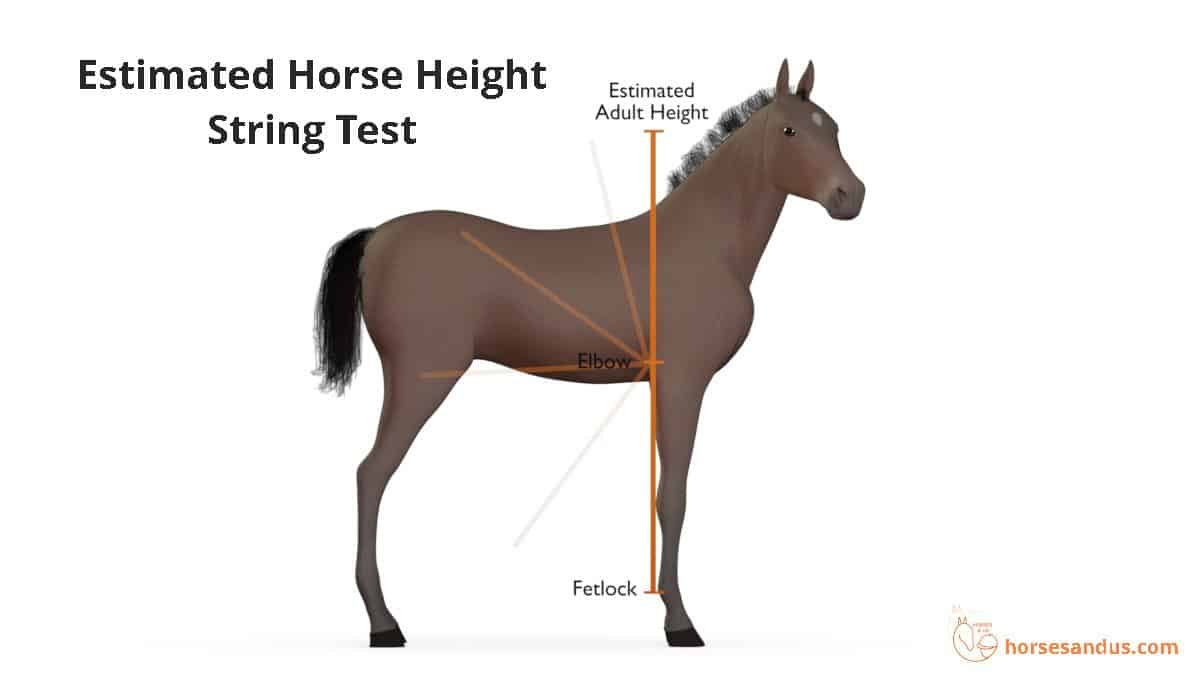
Cannon Bone Measurement
- Measure the distance between the middle of the foal´s knee and its coronary band.
- This measurement can be used to calculate the mature height
- converts directly to hands for the adult horse.
- Ex: 14,5 inches will be 14.5 hh when fully grown
- corresponds to 1/4 of the horse’s height
- Ex: 14,5 inches * 4 = 58 inches = 14.5 hh
- converts directly to hands for the adult horse.
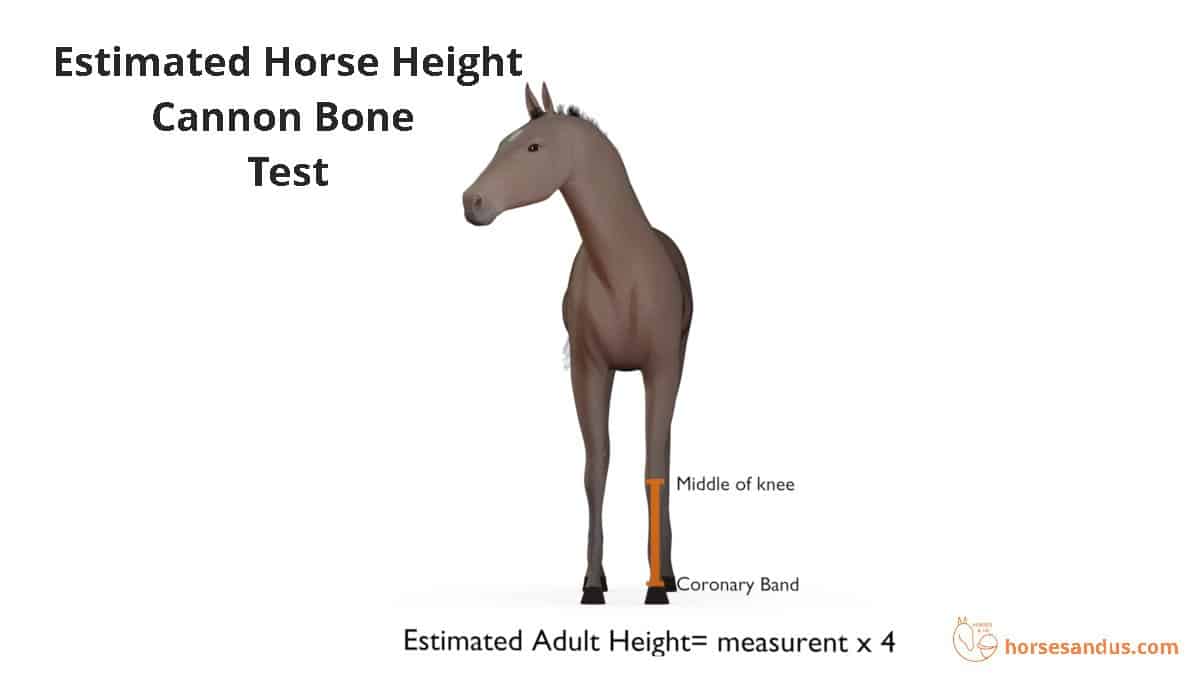
This method is more accurate if the horse is older than six months of age.
Foal’s Mature Height In Relation To Age
Although horse growth rates can vary based on breed, genetics, diet, and health, we can roughly estimate the foal´s mature size using the table below.
Measure the foal and divide its height by the percentage corresponding to the age.
| Foal’s Age | % of Mature Height |
|---|---|
| 3 months | 73% |
| 6 months | 82% |
| 12 months | 89% |
These percentages are based on research done on a large group of horses. (source)
Imprinting A Foal
Imprinting a foal is when humans try to bond with the foal as early as possible after birth. The first two days in a foal’s life is a very sensitive period when the “following response” is first learned.
The idea of imprinting foals was first introduced by Dr. Robert Miller, who was at the forefront of the horsemanship revolution. He developed and promoted safe and gentle horse handling techniques.
Imprinting should be done very carefully and with patience. The foal can panic and develop a fear of humans when applying the pressure and release methods used in imprint training.
However, if done correctly, imprint training is the fastest and most profound method to develop the horse’s attitude and response to training aids.
If you are interested in this idea you may want to read this book which can be found on amazon.
Sources
Article from Oklahoma State University
Article from Wiley Online Library
